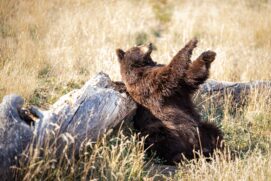Table of Contents
Bears are amazing mammals. They are massive, and powerful, and have inspired humanity since the dawn of time. We study their behavior and immortalize these animals in coats of arms, mascots, art, and tales.
But bears have a few mysteries left and one question that remains is why these creatures often make a gesture with their front paws that appear similar to hand waving. So, are they greeting you, or is something else going on?
This article covers a brief look at bears and their nature, and we also explain why they “wave.” Ready? Read on!
A Short History of Bears
The evolution of bears started a very long time ago. Bears are so ancient that their family goes back to 30 million years ago! Their ancestors were scientifically known as Miacids or Miacidae.
The scientific name for bears today is Ursidae. It comes from the Latin word Ursus/Ursa, meaning he-bear/she-bear. The word ‘bear’ actually comes from an old English word Bera. And, in the German language, it belongs to a group of names that are used to describe a bear.
The word ‘bear’ is also related to a Pro-Indo-European word, which means brown, so the word can also be related to the texture of the fur of this giant floof!
Why Do Bears Wave?
Bears are one of the most intelligent animals in the animal kingdom. When people hear the rumor that bears “wave” they wonder what’s going on and whether it’s an instinctive behavior of all bears.
Some people believe that the primary reason behind the waving is that bears have a sort of understanding of humans. This fanciful theory states that bears know people like it when animals respond with human gestures. The truth is probably a little different.
Bears learn quickly and some grasp that waving is rewarded by humans. They don’t have a clue that waving is a human gesture, they merely link it to the snacks that impressed humans give them when they flap a paw.
After proper research, three reasons were isolated as the most likely explanation for waving bears.
Reason 1: Getting Food
Bears need a lot of food to survive and build themselves up for hibernation. Over many years, bears have observed humankind and learned different ways to ask for food from us. These sneaky mammals have understood that we love it when an animal imitates human gestures and waving is a popular choice!
So, typically to gain food, these giants imitate the human wave and successfully get food! They know that if they wave, humans will appreciate it and thus, give them something tasty.
Reason 2: Dominance
Bears are strong animals. It is typical of them to show dominance. Their size usually determines their strength. However, to show a sense of superiority, you will find them standing tall and waving. Therefore, most of the time, they use the ‘wave’ gesture as a way of asserting their dominance over a person or another bear.
To be more specific, if you find cubs around bears and you see them waving, this is most certainly the reason behind it. It’s to warn other animals and humans that they are approaching too close to the bear’s young.
Reason 3: Protection
Bears can be protective over their cubs, and territory, or when they defend a carcass of an animal that they deem as their own food source. When they notice another bear or person, they will usually display aggressive behavior which might include standing upright and waving. Such a bear is not to be trifled with, especially animals that are defending food near hibernation time – they are known to be super aggressive when challenged for their food.
Survival Techniques
Have you ever wondered how these giants survive in extreme situations? Which survival hacks keep them alive?
Bears basically use the technique of hibernation (except for our cute giant panda). Hibernation is basically a state of maximum inactivity and many species rely on this remarkable ability to help them survive freezing temperatures during winters when food is scarce. During the warmer months, bears gorge to build up layers of fat and this also helps to see them through their period of winter hibernation.
Different Bear Species
Here are some of the most popular bear species you are likely to see in documentaries, wildlife reserves, and zoos.
Asiatic Black Bears
These bears are also known as moon bears or white-chested bears. They are typically found in Asia and are of medium size.
Brown Bears
They are also known as grizzly bears and their territory covers a large swath of North America. Furthermore, they are very large bears and are just second in size to the polar bear. They are also found in Eurasia and North America.
North American Black Bears
These bears are the smallest bear species in America and are luckily still present in large numbers. They are listed as the least concerned species by the list of IUCN (International Union of Conservation of Nature).
Polar Bears
This bear is the largest among its family members and is usually found in the Arctic region. Unfortunately, because of climate change, this poor thing has lost a lot of its natural habitat. It is now classified as a vulnerable species.

